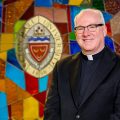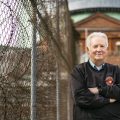Seton Hall and Hackensack University Health Network launch plans to create New Jersey’s only private medical school.
It is a proud but finite club — doctors who earned an M.D. from Seton Hall. But it is about to start growing again, as the University plans to open a medical school after more than 50 years without one.
“It developed a lot of good physicians,” said Dr. Gerald Levey, M.D.’61, one of the 348 graduates of the original Seton Hall medical school, who went on to become one of the nation’s leading medical educators. “We started with 80, but at the end of the second year we had pared the group down to about 69. The grading was very tough.”
Seton Hall had a medical school from 1956 until the mid-1960s, when it was absorbed into what became the University of Medicine and Dentistry of New Jersey, and discussions about starting another one have persisted over the decades since.

Over the last few years, the conversations became more focused. And in 2010, the University engaged a premier national healthcare strategy consulting firm to assess the feasibility of developing a medical school.
The analysis determined that — under specific conditions — this kind of undertaking was clearly achievable. A new medical school was strategically, politically and technically feasible. With the appropriate clinical partner, the project was also economically feasible.
Once the analysis was complete, Seton Hall began the extensive, yet delicate, effort to find an appropriate institutional relationship and partner.
“It has been an intense, concentrated endeavor,” said Brian B. Shulman, dean of the School of Health and Medical Sciences.
At a packed press conference in January, officials from Seton Hall and the Hackensack University Health Network announced their intention to establish a new four-year medical school. The location being considered is on part of the sprawling site in Nutley and Clifton, N.J., vacated two years ago by the pharmaceutical company Hoffmann La Roche, Inc.
When it opens, Seton Hall will become one of only five Catholic universities in the nation to have an allopathic medical school.
“We determined early in our deliberations that we wanted to have a relationship, and we found the right partner with the same values toward health care. The whole notion of servant leadership and compassionate care — that was all very important from our standpoint,” said University President A. Gabriel Esteban. “Hackensack will provide clinical opportunities not just for our potential medical students, but for our nursing, physical therapy, physician assistant, occupational therapy, speech-language pathology, athletic training and healthcare administration students. And in us they see a partner whose quality of graduates is well-known in the region.”
HackensackUHN, which is the largest healthcare provider in New Jersey now that its merger with Meridian Health is complete, has long been interested in a medical school, too. “Our academic reputation, combined with our clinical expertise, will guarantee the establishment of a world-class academic institution in the Garden State,” said Robert C. Garrett, president and CEO of HackensackUHN. “New Jersey has long been known as a home to the healthcare and pharmaceutical industries, and it is imperative we continue to support our future workforce through a premier school of medicine.”
Officials from Seton Hall and HackensackUHN have been meeting to discuss the details of their partnership and plan the shape of what will become the only private medical school in New Jersey.
“We know that by continuing to grow our academic core, we are going to grow our economic core as well,” Gov. Chris Christie, J.D. ’87 said at the announcement. “This would not have happened if it wasn’t for the willingness of Mr. Garrett and Dr. Esteban to step forward and say, ‘We will lead.’ That is the indispensable part of any great accomplishment — to have a person or people who are willing to step forward and take risks and lead — and that is what we have in both these gentlemen. That gives me great confidence about the future of the Hackensack University Health Network and my alma mater, Seton Hall.”
Several things were apparent as Seton Hall contemplated starting a medical school: it filled an identifiable need and it would further enhance Seton Hall’s reputation.
A new medical school would prepare more doctors in a state that needs them; the New Jersey Council of Teaching Hospitals expects the state to fall 3,000 doctors short of its needs by 2020. And a new school would meld naturally with the healthcare-related disciplines the University already educates students in: biology, chemistry, nursing, physical therapy, occupational therapy, speech-language pathology, athletic training, physician assistant, healthcare administration, health law, health sciences and post-graduate medical residencies and fellowships.
“The viability, need and benefit to the University were clear. The question was how feasible it would be for us to create a medical school,” said Larry A. Robinson, provost and executive vice president.
A medical school is a natural extension of Seton Hall’s mission as a Catholic university. But what helped persuade the provost, and in turn the president, that a new medical school was a feasible goal right now was the consulting firm’s report that examined the prospect of a partner in the venture. “Our deliberations led us to the point that if we had the right partner, if we had the right relationship, then it might be something that we might seriously want to consider,” Robinson said.
HackensackUHN emerged as the best fit, both philosophically and financially. “We’re all on the same page in terms of how we want to prepare future healthcare professionals,” Shulman said. “The future of health care is here and healthcare practitioners — whether they are physicians, nurses, or physical therapists, and others — need to learn about each other’s professions and need to learn to work together as members of the healthcare team to make a difference for the patients and the families they serve. This has always been my dream, to bring all of our professional health-science programs together.”
Seton Hall’s vision is ambitious enough for more than just a medical school. The University also is considering physically co-locating its School of Health and Medical Sciences and College of Nursing with the medical school, giving each the capacity to expand to meet growing demands, freeing up space on the crowded South Orange campus, and putting the new facility at the forefront of the recent movement in healthcare education known as IPE — interprofessional education.
“In order for all healthcare providers to understand each other, they need to better communicate, and it can start with their education,” said Marie Foley, the new dean of the College of Nursing. “There are certain things we can do together and certain things we cannot do together. This would be a phenomenal opportunity to move in this direction.”
“We have synergies I thought we could draw on,” President Esteban said. “We can model it on where we see health care going, which is the integrated approach to healthcare delivery.”
And the emphasis will be on preparing the kind of doctors both the nation, in general, and the state, in particular, are most in need of: primary care physicians. “They’re the ones who are going to coordinate your health care in the future, and that’s a great spot for someone who has a Seton Hall background,” said Esteban, whose own father was a primary care doctor who helped start a medical school in his native Philippines. “You get that sense of service that’s particular to a Catholic university and that’s what we hope to instill — that sense of giving back. That’s why we think they’re going to end up being in primary care, because if we’re successful in imbuing our values as a Catholic institution then I wouldn’t be surprised if more and more of our graduates decided to serve in a field where they’re going to impact the greatest number, and that tends to be primary care.”
That would please Dr. Levey, who retired in 2010 after serving 15 years as dean of the David Geffen School of Medicine at UCLA. “I think the country realizes now that we do have a deficit,” said Levey, who was an early advocate for the cause of educating more general practitioners when he became chairman of the Department of Medicine at the University of Pittsburgh in the late 1970s. “Whatever healthcare system we ultimately settle on, it’s very evident now that this country will at some point produce a good number of generalists. They better — it’s a real need.”
When Levey was a student, the medical school was in Jersey City, adjacent to Jersey City Medical Center, a location that made life easier, and cheaper, for him. “That’s the understatement of the year,” said Levey, who grew up on Van Houten Avenue in the city’s Greenville section, and lived at home as a medical student. “My mom’s cooking and having everything done, the laundry and everything else. It was really something special.”
The old medical school holds a prized spot in his memory. “We were very proud of that school,” he said. “It was a great bunch of young men and women trying to be successful. The students had that gung-ho spirit. It was just a very, very special time, I think, in all our lives.”
The old school was also special to Nicholas DeProspo, who first arrived at Seton Hall’s biology department in 1947, not long after serving as an Army medic in the Battle of the Bulge, and spent 25 years as the premed adviser for undergraduates. He was the founding dean of the School of Graduate Medical Education, which was renamed the School of Health and Medical Sciences. “I’m completely elated,” DeProspo said about plans for the new medical school. “It’s a dream come true. At age 91, it’s good to see something like this.”
Kevin Coyne is a freelance writer based in New Jersey.







